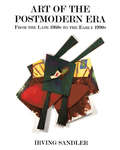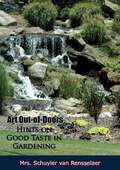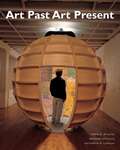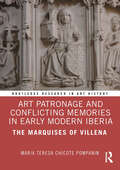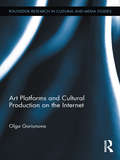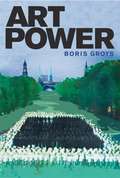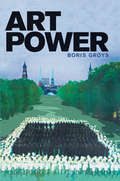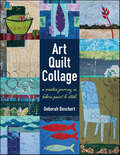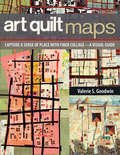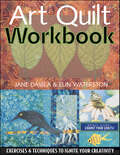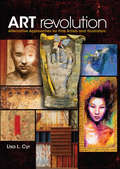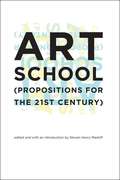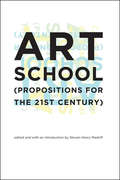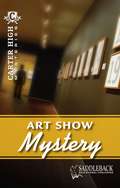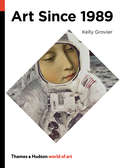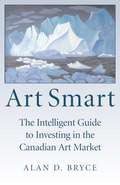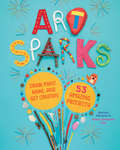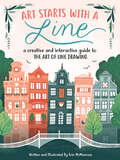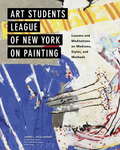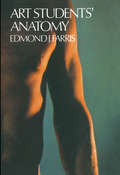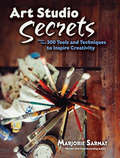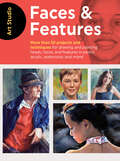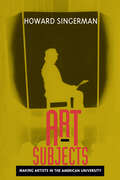- Table View
- List View
Art Of The Postmodern Era: From The Late 1960s To The Early 1990s
by Irving SandlerThe fourth and final installment in Irving Sandler's series on contemporary art, Art of the Postmodern Era surveys the artists, works, movements, and ideas as well as the social and cultural context of this energetic and turbulent period in art.The book begins with the late 1960s, when new directions in art emerged, ranging from diverse postminimal styles to pattern and decoration painting and new image painting. In turn, the 1980s ushered in a second wave of new movements?neoexpressionism, media deconstruction, and commodity art. Sandler also discusses postmodernist art theory, the art market, and consumer society, providing an essential framework for understanding the art of this period.Unlike his previous books, Art of the Postmodern Era includes both American and European artists.
Art Out-of-Doors: Hints on Good Taste in Gardening
by Mrs Schuyler Van RensselaerAn explanation of the essential principles of landscape gardening so that readers from all walks of life may admire the beauty of a well-designed formal garden.Landscape gardening as an art, in its practical application to the beautifying of country places, is the subject of a book by Mrs. Van Rensselaer, who writes with thorough knowledge and with fresh enthusiasm. She gives information and hints in abundance relating to the treatment of grounds, roads and paths, piazzas, pattern beds, trees and shrubs, etc., all animated by a fine artistic taste and a very genuine love of nature. It is very practical and helpful, and is written in the same agreeable manner that characterizes all of Mrs. Van Rensselaer’s writings.CONTENTS: THE ART OF GARDENING—AIMS AND MEANS—HOME GROUNDS—CLOSE TO THE HOUSE—ROADS AND PATHS—PIAZZAS—WINTER BEAUTY—A WORD FOR ARCHITECTURE—PATTERN BEDS—FORMAL GARDENING—THE BEAUTY OF TREES—BOTANY AND BEAUTY—THE ARTIST—THE LOVE OF NATURE, ETC., ETC.
Art Past Art Present
by David G. Wilkins Bernard Schultz Katheryn M. LinduffAuthoritative and substantive-yet accessible-Art Past, Art Present, 6th edition looks at the historical and cultural contexts of art works and architecture around the world from prehistoric times to the 20th century. The authors recognized the need for an easy-to-use format that is accessible for both teachers and students. Each topic in Art Past, Art Present is organized into two- and four-page units and provides a clear and concise treatment of a select number of artworks, making it easier for instructors to focus on what is important and for students to learn.
Art Patronage and Conflicting Memories in Early Modern Iberia: The Marquises of Villena (Routledge Research in Art History)
by Maria Teresa Chicote PompaninThis volume investigates the mechanisms (artworks, treatises, and other forms of cultural patronage) that the Marquises of Villena and their opponents used to operate in the cultural battlefield of the time with the aim of understanding how their conflicting historical memories were constructed and manipulated. Concentrating on the late fifteenth and early sixteenth centuries, the book examines these two aristocrats and demonstrates that political tensions led not only to military conflicts during this period but also to conflicts fought on cultural grounds, through the promotion of artistic, religious, and literary programmes. Maria Teresa Chicote Pompanin investigates why the Marquises of Villena lost in both the military and cultural battlefields and explains how the negative historical memories forged by their opponents in the late fifteenth century managed to become the official historical truth that has remained unchallenged to this day. The book will be of interest to scholars working in art history, cultural history, medieval studies, Renaissance studies, Iberian studies, literary studies, and patronage studies.
Art Platforms and Cultural Production on the Internet (Routledge Research in Cultural and Media Studies)
by Olga GoriunovaIn this book, Goriunova offers a critical analysis of the processes that produce digital culture. Digital cultures thrive on creativity, developing new forces of organization to overcome repetition and reach brilliance. In order to understand the processes that produce culture, the author introduces the concept of the art platform, a specific configuration of creative passions, codes, events, individuals and works that are propelled by cultural currents and maintained through digitally native means. Art platforms can occur in numerous contexts bringing about genuinely new cultural production, that, given enough force, come together to sustain an open mechanism while negotiating social, technical and political modes of power. Software art, digital forms of literature, 8-bit music, 3D art forms, pro-surfers, and networks of geeks are test beds for enquiry into what brings and holds art platforms together. Goriunova provides a new means of understanding the development of cultural forms on the Internet, placing the phenomenon of participatory and social networks in a conceptual and historical perspective, and offering powerful tools for researching cultural phenomena overlooked by other approaches.
Art Power
by Boris GroysGroys examines modern and contemporary art according to its ideological function. Art, Groys writes, is produced and brought before the public in two ways; as a commodity and as a tool of political propaganda.
Art Power (The\mit Press Ser.)
by Boris GroysA new book by Boris Groys acknowledges the problem and potential of art's complex relationship to power.Art has its own power in the world, and is as much a force in the power play of global politics today as it once was in the arena of cold war politics. Art, argues the distinguished theoretician Boris Groys, is hardly a powerless commodity subject to the art market's fiats of inclusion and exclusion. In Art Power, Groys examines modern and contemporary art according to its ideological function. Art, Groys writes, is produced and brought before the public in two ways—as a commodity and as a tool of political propaganda. In the contemporary art scene, very little attention is paid to the latter function.Arguing for the inclusion of politically motivated art in contemporary art discourse, Groys considers art produced under totalitarianism, Socialism, and post-Communism. He also considers today's mainstream Western art—which he finds behaving more and more according the norms of ideological propaganda: produced and exhibited for the masses at international exhibitions, biennials, and festivals. Contemporary art, Groys argues, demonstrates its power by appropriating the iconoclastic gestures directed against itself—by positioning itself simultaneously as an image and as a critique of the image. In Art Power, Groys examines this fundamental appropriation that produces the paradoxical object of the modern artwork.
Art Quilt Collage: A Creative Journey in Fabric, Paint & Stitch
by Deborah BoschertHow to get from "start" to "art" Make treasured art quilts from bits of cloth, stitched motifs, and painted details. Dip your toes into the world of art quilting with mixed-media techniques, practice exercises, checklists, and work-along projects presented using 8 design guides. This visual, step-by-step guide will help you unlock your own artistic vision as you quilt in a series, finish small art pieces, and incorporate meaningful symbols into your work. • Tap into your creative muse! Art quilt inspiration, techniques, and checklists presented in 8 easy-to-use design guides • Uncomplicated, visual guide to fabric collage with practice pieces to help you gain expertise • Tell your own artistic story with colors, materials, and beloved symbols
Art Quilt Maps: Capture a Sense of Place with Fiber Collage—A Visual Guide
by Valerie S. Goodwin“Working with paint, collage, and stitch, Valerie encourages readers to integrate poetry, memory, and personal experience into quilt maps that tell a story.” —Quilting Arts MagazineTransform the places you love—and places you’ve always wanted to see—into hypnotic art quilts. Award-winning artist Valerie Goodwin shows you how to make quilted maps with easy fabric collage techniques and innovative designs based on maps of your favorite places. The book features a large photo gallery of quilt maps by Valerie and her students.Find inspiration in real and imaginary sites, in old maps, in poetry, and in memoriesTransform a place’s essential lines and shapes into quilt designFully illustrated guide covers a variety of basic mixed-media techniquesMake luminous textures with fabric layering, paints, stamps, stencils, drawing, and appliqué“She teaches readers how to use road maps, tourist maps, utility company maps, as well as imaginary maps in quilting . . . At the end, she offers three treats: embellishing with haiku, designing travel maps with stones and shadows, and mapping memories and landscapes of families and homes.” —Publishers Weekly“Her style here is collage—a blend of texture, material and manipulation—and her theme is the map. Each quilt in her collection reflects a broad range of approaches to the maps she was inspired by. (Bonus: Her students’ gallery is total eye candy!) Delightful!” —Generation Q Magazine“This book is bound to appeal to the fiber artists among us . . . This book is a certified spring board to creativity. All I need now is some time!” —The Canadian Quilter Magazine
Art Quilt Workbook
by Jane Dávila Elin WaterstonDo-It-All Guide to Putting the ART in Art Quilts • Learn the basics of good design with simple step-by-step exercises, then add your own personal style • Develop the quilt artist within you • Explore fabric collage, thread painting, innovative piecing, and photo imagery on fabric • Learn about the business side of creating, exhibiting, and marketing your quilts Take your art quilts to the next level with Jane and Elin guiding the way. Do the lessons and homework, check out all the beautiful gallery quilts for inspiration, and find lots of resources for further study. *Important Note about PRINT ON DEMAND Editions: This title will be printed after purchase and will arrive separately from any in-stock items. Please allow approximately 2 weeks for USA delivery, with an additional 2 weeks for international shipments. Expedited shipping is not available on POD Editions. The printing quality in this copy will vary from the original offset printing edition and may look more saturated due to printing on demand by a high-quality printer on uncoated (non-glossy) paper. The information presented in this version is the same as the most recent printed edition. Any pattern pullouts have been separated and presented as single pages.
Art Quilts at Play
by Jane Dávila Elin WaterstonHave More Fun with Your Art Quilting! • Expand your artistic horizons and learn exciting new ways to play with surface design techniques and materials • Explore 22 different techniques and creative design effects • Stretch yourself artistically by connecting with other artists through online groups, art trades, and challenges • Get inspired by photo galleries of work created by other artists at play Packed with creative new surface design techniques and ideas for collaborating with artists in person and online, Art Quilts at Play is the perfect companion to Jane Dávila and Elin Waterston's bestselling Art Quilt Workbook. *Important Note about PRINT ON DEMAND Editions: This title will be printed after purchase and will arrive separately from any in-stock items. Please allow approximately 2 weeks for USA delivery, with an additional 2 weeks for international shipments. Expedited shipping is not available on POD Editions. The printing quality in this copy will vary from the original offset printing edition and may look more saturated due to printing on demand by a high-quality printer on uncoated (non-glossy) paper. The information presented in this version is the same as the most recent printed edition. Any pattern pullouts have been separated and presented as single pages.
Art Rebels: Race, Class, and Gender in the Art of Miles Davis and Martin Scorsese
by Paul LopesHow creative freedom, race, class, and gender shaped the rebellion of two visionary artistsPostwar America experienced an unprecedented flourishing of avant-garde and independent art. Across the arts, artists rebelled against traditional conventions, embracing a commitment to creative autonomy and personal vision never before witnessed in the United States. Paul Lopes calls this the Heroic Age of American Art, and identifies two artists—Miles Davis and Martin Scorsese—as two of its leading icons.In this compelling book, Lopes tells the story of how a pair of talented and outspoken art rebels defied prevailing conventions to elevate American jazz and film to unimagined critical heights. During the Heroic Age of American Art—where creative independence and the unrelenting pressures of success were constantly at odds—Davis and Scorsese became influential figures with such modern classics as Kind of Blue and Raging Bull. Their careers also reflected the conflicting ideals of, and contentious debates concerning, avant-garde and independent art during this period. In examining their art and public stories, Lopes also shows how their rebellions as artists were intimately linked to their racial and ethnic identities and how both artists adopted hypermasculine ideologies that exposed the problematic intersection of gender with their racial and ethnic identities as iconic art rebels.Art Rebels is the essential account of a new breed of artists who left an indelible mark on American culture in the second half of the twentieth century. It is an unforgettable portrait of two iconic artists who exemplified the complex interplay of the quest for artistic autonomy and the expression of social identity during the Heroic Age of American Art.
Art Revolution: Alternative Approaches for Fine Artists and Illustrators
by Lisa CyrWith an unprecedented array of media and digital tools at their disposal, today's artists are faced with unlimited possibilities for creative experimentation. Never before has there been such innovation in the way art can be conceptualized, produced and presented.Art Revolution is on the cutting-edge, exploring how artists are reinterpreting, reinventing and redefining everything from the surfaces on which they work to the way viewers interact with their finished pieces. This book ventures off the beaten path to track the creative directions and signature styles of twenty-one of today's most visionary artists, including Dave McKean, David Mack, Marshall Arisman and Cynthia von Buhler.Brilliantly illustrated with inventive examples of two-dimensional, three-dimensional, digital and new media art, Art Revolution will inspire you to break out of the confines of traditional thinking, push your content to a higher level, and revolutionize your personal approach to art.
Art School: Propositions for the 21st Century
by Steven Henry MadoffThe last explosive change in art education came nearly a century ago, when the German Bauhaus was formed. Today, dramatic changes in the art world--its increasing professionalization, the pervasive power of the art market, and fundamental shifts in art-making itself in our post-Duchampian era--combined with a revolution in information technology, raise fundamental questions about the education of today's artists. Art School (Propositions for the 21st Century) brings together more than thirty leading international artists and art educators to reconsider the practices of art education in academic, practical, ethical, and philosophical terms. The essays in the book range over continents, histories, traditions, experiments, and fantasies of education. Accompanying the essays are conversations with such prominent artist/educators as John Baldessari, Michael Craig-Martin, Hans Haacke, and Marina Abramovic, as well as questionnaire responses from a dozen important artists--among them Mike Kelley, Ann Hamilton, Guillermo Kuitca, and Shirin Neshat--about their own experiences as students. A fascinating analysis of the architecture of major historical art schools throughout the world looks at the relationship of the principles of their designs to the principles of the pedagogy practiced within their halls. And throughout the volume, attention is paid to new initiatives and proposals about what an art school can and should be in the twenty-first century--and what it shouldn't be. No other book on the subject covers more of the questions concerning art education today or offers more insight into the pressures, challenges, risks, and opportunities for artists and art educators in the years ahead. ContributorsMarina Abramovic, Dennis Adams, John Baldessari, Ute Meta Bauer, Daniel Birnbaum, Saskia Bos, Tania Bruguera, Luis Camnitzer, Michael Craig-Martin, Thierry de Duve, Cl mentine Deliss, Charles Esche, Liam Gillick, Boris Groys, Hans Haacke, Ann Lauterbach, Ken Lum, Steven Henry Madoff, Brendan D. Moran, Ernesto Pujol, Raqs Media Collective, Charles Renfro, Jeffrey T. Schnapp, Michael Shanks, Robert Storr, Anton Vidokle
Art School: Propositions for the 21st Century
by Steven Henry MadoffLeading international artists and art educators consider the challenges of art education in today's dramatically changed art world. The last explosive change in art education came nearly a century ago, when the German Bauhaus was formed. Today, dramatic changes in the art world—its increasing professionalization, the pervasive power of the art market, and fundamental shifts in art-making itself in our post-Duchampian era—combined with a revolution in information technology, raise fundamental questions about the education of today's artists. Art School (Propositions for the 21st Century) brings together more than thirty leading international artists and art educators to reconsider the practices of art education in academic, practical, ethical, and philosophical terms. The essays in the book range over continents, histories, traditions, experiments, and fantasies of education. Accompanying the essays are conversations with such prominent artist/educators as John Baldessari, Michael Craig-Martin, Hans Haacke, and Marina Abramovic, as well as questionnaire responses from a dozen important artists—among them Mike Kelley, Ann Hamilton, Guillermo Kuitca, and Shirin Neshat—about their own experiences as students. A fascinating analysis of the architecture of major historical art schools throughout the world looks at the relationship of the principles of their designs to the principles of the pedagogy practiced within their halls. And throughout the volume, attention is paid to new initiatives and proposals about what an art school can and should be in the twenty-first century—and what it shouldn't be. No other book on the subject covers more of the questions concerning art education today or offers more insight into the pressures, challenges, risks, and opportunities for artists and art educators in the years ahead.ContributorsMarina Abramovic, Dennis Adams, John Baldessari, Ute Meta Bauer, Daniel Birnbaum, Saskia Bos, Tania Bruguera, Luis Camnitzer, Michael Craig-Martin, Thierry de Duve, Clémentine Deliss, Charles Esche, Liam Gillick, Boris Groys, Hans Haacke, Ann Lauterbach, Ken Lum, Steven Henry Madoff, Brendan D. Moran, Ernesto Pujol, Raqs Media Collective, Charles Renfro, Jeffrey T. Schnapp, Michael Shanks, Robert Storr, Anton Vidokle
Art Show Mystery (Walker High Mystery #1)
by Eleanor RobinsPaige wants to enter her painting in the art show, but thinks someone has stolen it. It isn't where she thinks she put it.
Art Since 1989 (World of Art)
by Kelly GrovierAn extensive, accessible guide to the most groundbreaking and influential art from 1989 to the present The years since the collapse of the Berlin Wall in November 1989 have seen the rise of a new freedom to define art—Who makes it? Where can it be found? What is its commercial value?—and, consequently, the reevaluation of art’s place in society. Kelly Grovier surveys the dynamic developments in art practice worldwide since 1989, focusing on artists whose fresh visual vocabulary and innovation reflect these past turbulent decades. The book’s ten chapters examine the key themes in contemporary art—portraiture in the age of face transplants and facial recognition software, political activism, science, and religion, to name a few—by artists including Jeff Koons, Louise Bourgeois, Damien Hirst, George Condo, Marlene Dumas, Sean Scully, Cindy Sherman, Banksy, Ai Weiwei, Antony Gormley, Christo and Jean-Claude, Jenny Holzer, Chuck Close, and Cornelia Parker. A chapter-length timeline at the end of the book traces the evolution of art from 1989 to today by closely examining one key artwork from each year. Illustrated with the work of over 200 key artists, Art Since 1989 is a lucid and engaging look at what may prove to be one of the more tempestuous eras in human history, if not the history of art.
Art Smart: The Intelligent Guide to Investing in the Canadian Art Market
by Alan D. BryceArt Smart is a comprehensive guide to the Canadian art market for both novice and experienced collectors. It is full of advice that can give anyone the tools to determine the value of a piece of art and to not be intimidated by the often mystifying world of art. This informative and helpful volume covers the inner workings of the art market, from dealer trade secrets to expert strategies on buying and selling through auction houses and online. Art Smart gives the reader the knowledge needed to build a collection for long-term investment value, and also covers tax and estate planning, copyright issues, and charitable donations. It also contains all the latest resources for art research, with useful appendices to guide the art consumer in becoming their own art connoisseur. Art Smart is essential reading if you are curious to know more about how the art market functions and is an excellent resource guide for those already involved.
Art Sparks: Draw, Paint, Make, and Get Creative with 53 Amazing Projects!
by Marion Abrams Hilary Emerson LayEvery kid can be an artist with this book as their guide! Using basic art supplies — from paint, markers, paper, and glue to household finds like cardboard boxes and fabric scraps — children aged 6 and up learn that as long as they can imagine it, they can create it. Curated by two art educators with decades of experience, this rich collection of 53 arts and crafts activities offers up a ton of freeform fun, from Doodlemonsters and Painted Animal Rocks to Paper Bead Jewelry and Nature Weaving. Projects vary in difficulty so there’s something for a wide range of ages and abilities, and many can be completed in under an hour. Each project featured in the book has been kid-made (and kid-approved!), and colorful photos of the finished pieces will ignite a creative spark that inspires budding makers to express their imagination, humor, and individuality through art. This publication conforms to the EPUB Accessibility specification at WCAG 2.0 Level AA.
Art Starts with a Line: A Creative and Interactive Guide to the Art of Line Drawing
by Erin McMannessEverything you need to master the art of line drawing, whether the goal is to draw for fun or illustrate an original masterpiece!Line drawing involves using a combination of fine lines and bold strokes to create artwork of any kind—from basic folk art to more sophisticated illustrations. This form of art requires minimal tools, making it both affordable and portable. In Art Starts with a Line, artists of all skill levels are invited to learn how to draw almost anything starting with simple lines and basic shapes.Following a brief introduction to tools and materials, as well as some easy exercises and techniques for warming up to basic drawing tools, you will explore a variety of subjects. You’ll draw plants and flowers, architecture and cityscapes, animals, and everything in between. These projects aren’t restricted to black and white either! You’ll find techniques for adding color with colored pencil, marker, pen, even digitally.Art Starts with a Line presents everything you’ll need to know to learn how to successfully create line drawings of all types. Whether your goal is to create a custom logo for a client, or to simply decorate your planner—it’s all here. Packed with engaging instruction, tips, and beautiful step-by-step artwork, this approachable, inspiring guide to line drawing shows beginning artists how to create meaningful artwork using simple lines and mindful prompts.
Art Students League of New York on Painting
by James L McelhinneyA lushly illustrated, comprehensive guide to painting in all media from the prestigious visual arts education institution Art Students League of New York.The Art Students League of New York is America's signature art school, run by artists for artists. Founded in 1875, it has nurtured students like Jackson Pollock and Georgia O'Keefe. Today, more than 2,500 students of all ages, backgrounds, and skill levels study there each month. This unique book brings you into the studio classrooms of some of the League's most celebrated painters--including William Scharf, Mary Beth McKenzie, Henry Finkelstein, and Knox Martin--for lessons on a variety of fundamental topics, idiosyncratic approaches, and quirky philosophies. Scanning the table of contents is like flipping through a course catalog: do you want to take Naomi Campbell's "Working Large in Watercolor," James McElhinney's "Journal Painting and Composition," Sharon Sprung's "Figure Painting from Life in Oil," or Ellen Eagle's "Poetic Realism in Pastel"? Now you can--from the comfort of your own home studio (or living room). Richly illustrated with artwork from the League's considerable archives, its instructors, and its students, this guide will inspire painters across all mediums, subjects, and styles.From the Hardcover edition.
Art Students' Anatomy
by Edmond J. FarrisA long-time favorite in art schools. Basic elements, common positions, and actions. Full text, 158 illustrations.
Art Studio Secrets: More Than 300 Tools and Techniques to Inspire Creativity (Dover Art Instruction)
by Marjorie SarnatAward-winning illustrator and painter Marjorie Sarnat presents an outstanding refresher course in creative thinking, suitable for artists of every level. In this guide, she shares the tips and techniques she's discovered in the course of her personal experiences and explorations. These 300 quick, easily grasped text passages detail methods for adding inspiration and innovation to your creative process. The new, hands-on approaches to materials, painting surfaces, and texture applications can help you find a fresh angle for your style or break through a creative block.Every "secret" in this book is expressed in practical terms geared toward boosting your artistic abilities. From sharpening your drawing skills and applying media in unique ways to creating intriguing visual illusions and refining your choices of color and composition, this guide is loaded with advice and fresh ideas. You'll also find cost-saving ways to obtain and manage your art tools and supplies as well as scores of ideas for making art with creative kids.
Art Studio: More than 50 Projects and Techniques for Drawing and Painting Heads, Faces, and Features in Pencil, Acrylic, Watercolor, and More!
by Walter Foster Creative TeamAn introduction for beginning artists and art enthusiasts to methods of drawing and painting heads, faces, and expressions using a variety of mediums. Drawing and painting heads, faces, and expressions can be an intimidating prospect for a beginning artist. Art Studio: Faces & Features is here to help, with more than fifty tips, techniques, and step-by-step projects that will have you creating expressive faces and mastering textures in all your drawings. This intuitive guide shows you how to work with graphite and colored pencils; acrylic, oil, and watercolor paints; pastels; and even pen and ink. This range of mediums is the perfect way to experiment, build artistic confidence, and define your own unique style. Art Studio: Faces & Features makes the art of drawing expressions possible for beginning fine artists. The Art Studio series is designed to help beginning artists venture into fine art; an overview of each art medium helps them determine which they like best.
Art Subjects: Making Artists in the American University
by Howard SingermanNearly every artist under the age of fifty in the United States today has a Master of Fine Arts degree. Howard Singerman's thoughtful study is the first to place that degree in its proper historical framework and ideological context. Arguing that where artists are trained makes a difference in the forms and meanings they produce, he shows how the university, with its disciplined organization of knowledge and demand for language, played a critical role in the production of modernism in the visual arts. Now it is shaping what we call postmodernism: like postmodernist art, the graduate university stresses theory and research over manual skills and traditional techniques of representation.Singerman, who holds an M.F.A. in sculpture as well as a Ph.D. in Visual and Cultural Studies, is interested in the question of the artist as a "professional" and what that word means for and about the fashioning of artists. He begins by examining the first campus-based art schools in the 1870s and goes on to consider the structuring role of women art educators and women students; the shift from the "fine arts" to the "visual arts"; the fundamental grammar of art laid down in the schoolroom; and the development of professional art training in the American university. Singerman's book reveals the ways we have conceived of art in the past hundred years and have institutionalized that conception as atelier activity, as craft, and finally as theory and performance.
